2005 diary
2005
Sun Dec 18
Cold wave that attacked Japan last weekend brought us heavy snow and citizens
in my city were busy to plow snow on the roof. This photo was taken yesterday:
the sky was clear as you see and it had been fine for two days. Unfortunately,
I did not comet hunt due to full moon.
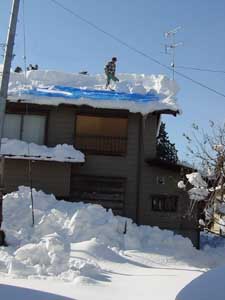
Cold wave that is stronger than that of last weekend is passing through
Japan now. Snow depth in my city is over 1.5 m (5 feet) this evening and
it is still increasing. In these 20 years, this is the deepest record in
December: Snow depth over 2 m was observed in December, 1984.
My diary reads I comet hunted 4 days in December in both 2003 and 2004.
This month I did twice. There may be still chance to do and there may be
still chance to discover.
Thu Dec 1
It has been depressing weather for over one week. This is fate for those
who live on the Japan Sea side in this country in winter. Cold wind from
the continent blows over the surface of the Japan Sea that supplies moist
air and hit to the mountains and it brings us snowy weather.
On the Pacific Ocean side where Tokyo, Yokohama, Osaka and other most
big cities are located, there are many fine days with dry in winter but
the Japan Sea side is completely opposite. Ikeya, Seki, Fujikawa, Tago,
Utsunomiya, Takamizawa, the late Honda and Hyakutake... are all the Pacific
side or inland residents.
You can go nowhere if you say so. There are some positive sides here.
If it is fine almost every day, you must get tired. It is happy there are
no serious light pollution sources, i.e. large cities, near here. An exception
is ski field in wintertime; it would open at the end of this month. Everything
is not always perfect.
OK, anyway, the sky was clear this evening and I searched comets for
one hour and forty minutes.
Before I began to comet hunt, I observed C/2005 E2 McNaught. It was
11th magnitude with an altitude of 24 degrees and discoverable image with
my 18-inch comet seeker, even though the evening sky was moderately light
polluted.
I stared from Altair at 6:15p.m. and finished at the position
where Comet McNaught was at 7:55p.m. The comet was not able to see at that
time since the altitude was only 8 degrees with light pollution. I could
catch most of all the star clusters that I expected to see in the area:
M11, NGC6712, 6934, M2 and M72. The area I covered was about 35degrees wide
x 40 degrees height.
After the comet searching session, I enjoyed observing Mars, 29P (some
14th magnitude), and deep sky objects. The degree of light pollution reduced
after 9p.m. and I could recognize M33 by averted vision. Counter glow was
apparent! I am planning to construct an observatory next spring here, today's
observing site, and the owner of this farm land gave me positive reply.
This may be the last satisfactory observation this year here.

Predetermined spot of my observatory. 20 minutes drive from my house.
Flashes of lightening brightened the sky many times during the comet
hunting session, and after that it became stronger in spite of clear sky.
I knew that the rain storm was approaching. When I got home I looked at meteorological
information in the Internet and the storm cloud was on the Japan Sea, some
100 km (63 miles) away from my city. Cloud began to cover the sky before
10p.m. and storm attacked my city at predawn.
Fri Nov 11
Under clear sky, I caught 27 galaxies and one globular cluster (M3).
One of the darkest one was NGC4156, the Sky Vector said it has magnitude
13.2.
I swept the sky vertically from an altitude of some 40 degrees to the
horizon. Every time my telescope field reaches the horizon, I move the telescope
northward so that the field overlaps 1/3. Then, I train my telescope on
an altitude of about 40 degrees again and from that altitude I move it downward.
I sweep downward only. During the twilight I caught three 11th magnitude
galaxies, a galaxy group, NGC5350, 5353 and 5345. At the next sweep I suppose
I could catch those galaxies, however, I could not.
I returned back my telescope and checked why I could not. The galaxy
group passed through at the edge of the field and I could not notice them.
Moreover, I noticed that I had missed brighter galaxy than the galaxy
group! NGC5371, it is 10th magnitude. How difficult it is to keep concentration.
When I was disappointed with my poor ability and looked up the sky,
the zodiacal light looked brighter than usual and reached near the zenith.
C/2005 T4 (SWAN) was discovered from the SWAN image. It was 10th magnitude
at the beginning of October in the evening sky. I comet hunted on Oct
6 in the evening but the time when I began to sweep the comet had already
set. You have still enough possibility to find a comet.
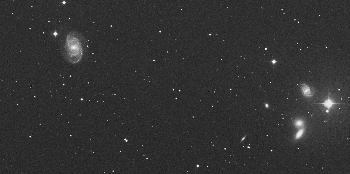
Left: NGC5371. Rgiht: NGC5350, 5353 and 5345. Width of the image: 30�f
The Digitized Sky Survey copyright © 1994
Fri Oct 28
At this predawn transparency was not very good and the sky was a little
bit hazy. The Crescent moon was at the heart of Leo that made the condition
worse. It was warm for the end of October and this must be one of the
causes of poor sky condition.
I began to sweep the sky from Hydra at 3:25a.m. and caught only NGC3242
(planetary nebula) and 3115(galaxy). At 4:40 a.m. northeast to south sky
was covered with thin cloud. Then, I trained y 18�h telescope on the Big
Dipper. M51 was easy to catch but M109 was overlooked. I noticed that
my telescope field had just passed through Gamma UMa and I went back to
the star. I found M109 in the vicinity of Gamma UMa; both of them could
be seen at the same telescope field. Dazzling of Gamma UMa made it
difficult to recognize M109. If it were not for the star I could have
never failed to overlook M109.
To change the subject,�@I bought TeleVue�fs binoviewer, Bino Vue,
to enjoy Deep Sky Objects, planets and Moon. After the comet hunting session
at 5:00a.m. I tried to make the first light of this apparatus by observing
Mars. The first step was to observe Mars with single eye with 297x. The
Central Meridian was about 170 degrees. Mare Sirenum and Mare Cimmerium looked
like the shape of twisted string, which crossed the surface.
Three minutes after that, when I was preparing Bino Vue, Mars was
hidden by a tree! I had no choice and observed Moon. The sky was already
bright and it was not very impressive in comparison with single eye view.
But it was much more comfortable than observing by single eye. It is said
that you can enjoy 3-D view of the Moon and can observe details of planets
and nebulae by seeing two eyes.
I do not have idea to use Bino Vue for comet hunting. It is not only
2�h size eye piece acceptable but significant light loss occurs. I read
somewhere that utilizing a binoviewer reduces limiting magnitude by about
0.5. 2�h size binoviewer is available from Sierbert Optics in USA. On the
contrary, you can observe some 0.5 darker stars in magnitude by using a
binocular or a bino-telescope than using the same size single eye telescope.
Sat Oct 8
Predawn hunting session: Transparency was excellent! The amount of
cloud changed from 2-9 (10 means cloud covers all the sky) but there
were always some gaps among the cloud in the eastern sky. I swept here
and there training my telescope on the cloud gaps.
NGC2359 in Canis Major was interesting nebula in its shape. I thought
I observe this nebula for the first time, but I did it on December 29 in
2000 with my 8�h telescope when I enjoyed observing deep sky objects: I
found a memo in �gThe Night Sky Observer�fs Guide�h.
On Thursday I enjoyed the summer Milky Way and at this predawn the
winter Milky Way. How luxurious it is!
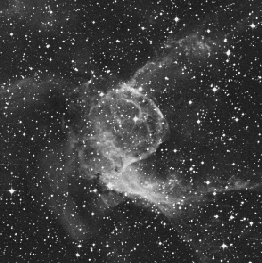
NGC2359 in Canis Major: size 15�fx15�f, north is up.
Only bright part of the nebula (south) was seen in the comet hunting
session.
The Digitized Sky Survey copyright © 1994
Fri Oct 7
Transparency at this predawn was apparently inferior to that of last
evening, though it had been clear sky since last evening. I trained my
telescope on Leo mainly. All the nebulae I caught were only NCG2903, and
NGC2964-2968.
The zodiacal light extended from Leo and was almost vertical to the
horizon.
Thu Oct 6
I caught a cold and got sick leave last week. This was the first
comet hunting session this month.
In spite of good forecast, it was cloudy when I left my office. Just
at the end of the twilight, clear sky spread! I drove to the observing
site and began to hunting at 7:35 p.m.
Usually, evening sky tends to have lower contrast than predawn sky
because of light pollution, however, this time it was excellent. The
summer Milky Way was crystal clear and impressive. I was completely satisfied
with the searching session.
I caught NGC6445 in Sagittarius, a planetary nebula with the diameter
of 34�h, at the altitude of some 15 degrees: it was the resolution limit
of my telescope under the condition; I could manage to distinguish the object
from stars. Surprisingly, I could not notice NGC6440 at that time that
is a globular cluster located 22�f south of NGC6445. Both of them must
be seen in the same field of 1.3 degrees in diameter. NGC6440 is the 9
th magnitude which is 2 magnitude brighter than NGC6445.
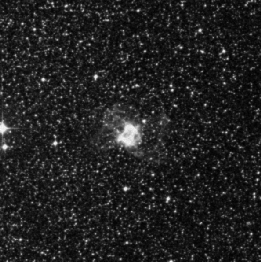
NGC6445 in Sagittarius: size 10�fx10�f, north is up.
The Digitized Sky Survey copyright © 1994
Sat Sep 17
Moon set at 3:59 a.m. and the end of twilight began 4:00 a.m. I
hesitated whether I had a comet hunting session. I decided to because
from the next day I would not be able to do it for several days due to
moon light on top of cloudy forecast for the coming week.
This predawn I employed 15x110 mm binocular since I do not have
enough time. I stared to sweep the low altitude sky horizontally at 3:40
a.m. The area I covered was 90 degrees wide x 20 degrees high. When I finished
sweeping this area the lower part of the sky already became brighter.
Then I began to search vertically and swept 60 degrees wide x 30 degrees
high: this area overlapped with the former area I swept. I stopped searching
at 4:30 a.m. and the total time I spent was 50 minutes.
Open cluster NGC 2360 I caught this time was bright enough to notice
by the binocular. It has the magnitude of 10.0 according to the Tago
catalog (published by a Japanese comet hunter Akihiko Tago), and of 9.5
based on the Seki catalog (by Tsutomu Seki). However, I doubted these data.
It looked brighter for me.
After that I checked some catalogs and found that the brightness
is described as 7.2 in the MegaStar version 5. I think this value is
reasonable: however, the brightness of defuse objects like star cluster,
nebulae and comets is difficult to determine and depends on the telescopes
and/or the sky conditions in many cases. Tago and Seki used 6" (15 cm)
reflector, 5" (12 cm) binocular, and 6" (15 cm) binocular with magnifications
of 20-30x. NGC 2360 must look darker if I would use larger instruments
with higher magnifications.
Fri Sep 9
I got up at 1:48 a.m. and left home for new observing site where
I scouted a few days before in the day time. After 10 minutes drive fog
covered the road. The new site was affected by fog rose from the Shinano
River, one of the main rivers in Japan. I decided to return and I began
to comet hunting in front of my residence.
I remember I had visited and checked more than one dozen of observing
sites. These sites must be visited both in daytime and nighttime. In
the day time I have to check the parking space and the route, in the
nighttime evaluate a degree of light pollution. Usually, there are some
unexpected factors that prevent comfortable observation, and it is not
easy to find a good site for comet hunting.
I cannot help being conscious searching for Kreutz group comets
in this season, and tried to search eastern low altitude.
Transparency was pretty good and NGC1788 looked like a defused
comet with a diameter >6�f.
There are many fine days this month, as if it compensates for
unseasonable weather last month.
Mon Aug 29
I got up at 2:10a.m. The crescent moon was bright! I went out
to comet hunt, however, thick cloud moved toward me and covered all the
sky. I waited for half an hour but nothing had changed and went to bed.
I had a doze and felt chilly. I saw the sky again. It was clear!
It was 3:27a.m.: only 10 minute before the beginning of the twilight.
There was no time to assemble 18�h telescope and I decided to use 15x110mm
binocular. This predawn, I could comet hunt for the first time this month
for 30 minutes.
In the evening I went to comet searching again. Before I did
it, I wanted to observe C/2005 P3 SWAN that was discovered by
Hirohisa Sato and many other web comet hunters. It had been possible
to find this comet visually since early this month. I felt it was pleasure
this comet was found first by Japanese web comet hunter on the unseasonable
weather condition all over Japan this summer.
I could manage to see C/2005 P3 but it was difficult to observe;
it was at low altitude, affected by light pollution and sometimes thin
cloud covered it.
After the observation, I could comet hunt only 20 minutes due
to cloud cover. Even so, I was satisfied to observed C/2005 P3. You still
have a chance for visual discovery.
Sun Aug 14
It has been unseasonable weather this summer. The Meteorology
Agency declared the end of the rainy season three weeks ago and temperature
has been high since then. I could hardly see clear sky, however. I wonder
if I will be able to comet hunt this month.
Last month I purchased a book written by Tsutomu Seki with an
Internet auction and read it yesterday. The title is �gHoshi zora no
kayudo�h, or �gHunter of the starry heavens�h in English published in
1978, which goes out of print now. The content of the book is based
on the�@other his publication �gMichi no hoshi wo motomete�h, or �gSeeking
for unknown stars�h published in 1960�fs that I have already read.
 �gHunter of the starry heavens�h by Tsutomu Seki
�gHunter of the starry heavens�h by Tsutomu Seki
Even so, the book was very impressive and enlightened me like
the other books written by him. I owed mental energy to him heavily
and I guess the same holds true many comet hunters and comet researchers
in this country. Please let me quote one of the most impressive paragraphs
in the book;
[Seki stayed Honda�fs residence.]
I got up. Then, I saw my watch and the short hand indicated
3 a. m.
<An omission of a middle part of a passage>
Probably, Honda was worrying about the weather. The weather
forecast said there is no chance of clear sky because depression covers
Western Japan. Even so, Honda got up a few times and was checking the
sky condition. He must start observation if he could find a small gap
in cloud.
I felt I saw the most beautiful moment of the man who pursues
ideal way of living. At the same time, I felt as if I had learned,
from his figure, all the greatness of Honda as an astronomer.
Thu Jul 28-Fri Jul 29
This is the first and probably the last comet hunting session
I have this month: it has been cloudy throughout July in my city including
the period while I was in Hawaii.
In Thursday evening, I drove 45 minutes and arrived at the
observing site at the altitude of 2789 ft, 30 minutes before
the end of twilight. The sky was clear. Just after I had assembled my
18�h Dobsonian, 90% of the sky was covered with cloud. I comet hunted
training the telescope on the gaps of the cloud. For some time cloud completely
covered all the sky and I could not help stopping the searching. I went
to bed in my car at 10:20 p.m. after one net hour comet searching session.
I got up at 2:00 a.m. at the predawn on Friday. The sky was
clear but bright with the last quarter moon. This time I was not bothered
by cloud cover and was satisfied with the session.
Before I disassembled my telescope, I enjoyed watching the
Mars. A large south polar cap was impressive.
Last Saturday, two days after full moon, I went to one day
hike for Mt. Naeba 7037 ft (2145 m).

Sun Jul 10
I got back from one-week tour of the Hawaii Island.
One highlight of the tour was Deep Impact observation, but
the deference in appearance and/or brightness of the comet Tempel
1 (9P) before and after the Impact was very slight. However, I was
excited by and completely satisfied with the dark sky near the top of
Mt. Mauna Kea.
Another highlight was visiting Subaru Telescope and other
Giant Telescopes at the summit of Mt. Mauna Kea, 14000 feet (4200 m).
It was very impressive and gave me energy to enjoy astronomy; one of
the reasons is that we drove to the summit by ourselves!
The impression of the observation and tour photos are posted
here.
The University of Hawaii offers detail information on the
Mauna Kea Observatories:
Aerial Tour of the Mauna Kea Observatories
http://www.ifa.hawaii.edu/images/aerial-tour/aerial-tour.html
Summit map
http://www.ifa.hawaii.edu/ifa/maps/summit_map.htm
Mauna Kea Telescopes
http://www.ifa.hawaii.edu/mko/telescope_table.htm
Wed Jun 15
Suddenly, a couple of weeks ago, I have decided to go to
Hawaii with my friend to observe �gDeep Impact�h on
July 4 (July 3 in Hawaii). I have been busy to get ready for the
travel.
We are going to observe it at the Onizuka Center for International
Astronomy -- Visitor Information Station with an altitude of 9,300
feet (2800 m), which is situated on the way of the summit of Mauna
Kea, in the Big Island, Hawaii. Of course, we will also visit the top
of the Mauna Kea, where there are many giant telescopes.
I would like to take my 8�h reflector and 5�h ED�@refractor
for visual observation only. It is exciting to imagine what would
happen, and even if nothing happens it must be great to enjoy star
watching under the dark sky in Hawaii!
Thu May 26
This evening the transparency was much worse than that
of yesterday. Again, I went for comet hunting and again, cloud began
to cover the sky. The amount of cloud was less than that of yesterday,
but it was boring to do comet hunting under such unfavorable condition;
poor transparency and cloud. I stopped the session in one hour.
After that, I observed 9P/ Tempel and C/2004 Q2 Machholz.
The brightness and the shape of 9P looked steady. C/2004 Q2 faded
away; nevertheless I could observe two kinds of tails.
Wed May 25
Clear sky! I decided to go for comet hunting this evening,
even though there was only some 15 minutes from the end of the twilight
to the moonrise.
Just after the beginning of the comet hunting session
cloud began to spread and I was forced to train my telescope from
the west to the northwest, the northwest to the south to search among
the gap of the clouds.
Sat May 7-Sun May 8
I went on an observation (brightness measurement and making a sketch)�@deep sky watching
and comet hunting to Gunma Prefecture, one hour drive from my house,
because of cloudy weather here in Niigata Prefecture. Transparency
was excellent and I enjoyed all through the night.
C/2004 K1 (Catalina) was observed with a magnitude of
15.0 that was the limit of my 18�h telescope. I could not recognize
it with 170x at first but it was observable with 291x.
I caught 21P/Giacobini-Zinner during the predawn comet
hunting session and I thought it was a galaxy at first. However,
the digital setting circles said that there was no galaxy there and
I assumed it must be 21P. I could confirm it pretty soon with the star
chart I printed out in my house before leaving.
Thu May 5
There are many national holidays this week, what we call
�egolden week�f, and most workers take one week or longer vacation
in Japan.
I went to on a mountain climbing to Japanese North Alps
from Monday night to Thursday with two members of my mountaineering
club. We crossed from Mt. Tsubakuro (2762.9 m) to Mt. Jyonen (2857
m). It had been fine through the period and I enjoyed. However, I had
been worried that the appearance of a new comet and its discovery while
I was in the mountain.
Comet hunting requires physical and spiritual strength:
to feed both of them I continue to go on a one day mountain climbing
(or one day skiing in winter) a few times every month. This time it
was a three-days climbing that refreshed me much more than a one-day
activity.
Photos are taken on May 3.
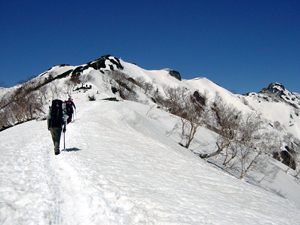
Toward the ridge of Japanese North Alps.
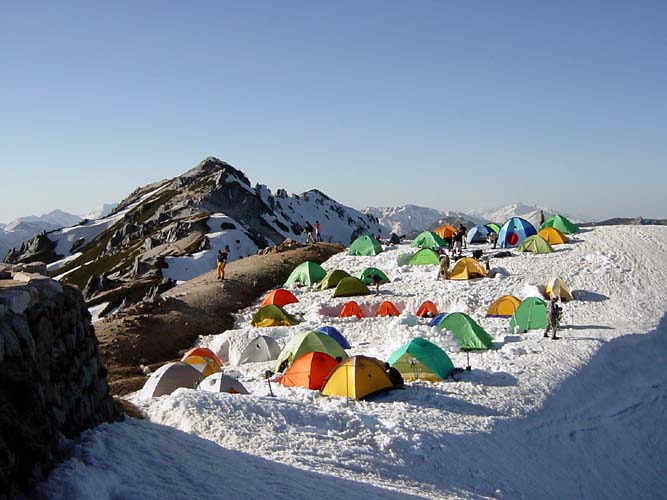 Click the photo to enlarge!
Click the photo to enlarge!
The tent site and Mt. Tsubakuro-dake (2762.6 m).
Sat Apr 30
The stars looked crisp this predawn regardless of under
almost the last quarter moon light.
I caught only two nebulae and a star cluster during
2 hours searching: M27, M13 and NGC7331. The last one was caught
after 30 of the beginning of the twilight at an altitude of 40 degrees.
In contrast to the last Wednesday, I had a feeling of satisfaction
today.
Wed Apr 27
This evening�fs comet hunting session was unsatisfactory:
light pollution reduced the contrast of the star field, especially
at low altitude. I was sick of searching tonight and stopped it in
one hour. Then, I observed some objects.
C/2004 Q2 Maccholz is still bright with two tails. Both
the type I and the type II tails has about 0.5 degrees in length.
9P Tempel has a wide tail that is about 3�f long. The
degree of concentration (DC) is 6.
M13 in spite of the bright back ground, it looked wonderful.
Each resolved star twinkled vividly.
M81 spiral structure is not apparent but the changes
in the brightness in the nebula are a hint of it. Structure in M82
is clearly seen.
I also enjoyed Jupiter and Saturn.
Sun Apr 10
There was no cloud today but transparency was apparently
worse than that of yesterday. All the ski fields finished their
predawn service and the light pollution reduced at predawn, even so
it is difficult to find an 11 th magnitude comet with my 18�h telescope
under this poor transparency.
I enjoyed two hours of seeking and detected over two
dozens of nebulae and star clusters; most of them were globular
clusters in Sagittarius, Serpense, Scutum and so on.
Sat Apr 9
The sky was clear last evening but was cloudy at this
predawn as the forecast said. Even such a condition I went to comet
hunting.
I spent one hour and forty minutes for the comet seeking
session, however, I saw the sky through thin cloud about half the
time of today�fs session. On top of that, throughout the session
there was stagnant cloud at an altitude of 20 degrees or lower.
Sometimes the telescope field I was observing was clear
without cloud and the Milky Way in Cygnus was impressive. Whole
the sky was covered with cloud just after the twilight began.
Sun Mar 20
A host of fine stars in the Summer Milky Way seemed
as if they had played a cembalo. Some bright stars that suddenly
came into my telescope field sounded like timpani that strongly echoed
in the heaven; I could listen to a tone color of them in my mind.
It was indeed comfortable comet hunting session this
predawn with the aid of excellent transparency.
Wed Mar 10
This predawn, it would have been the third comet
hunting session of this month.
I believed clear sky and I got up at 2:30am.
At the next moment, I suspected it since I did not feel cold.
If it had been clear sky, it would have been colder due to radiation
cooling.
It was a dense fog! I wonder if I could escape from
the fog at the observing site. Anyway, I headed for the site. On
my way to the site my car popped out from the fog and I could recognize
some stars in the sky. I was sure to do comet hunting.
However, when I arrived at the site thin cloud covered
all the sky. I waited for half an hour but nothing has changed.
I got back my home before 4am.
Thu March 3
Eighteen days has passed since I comet hunted last.
It has been snowy or cloudy and I could comet search only twice
in February. Snow in my workplace is still 8.7 feet (2.6 m) deep.
Usually, number of clear night raises from this month and in fact
the forecast says clear sky expands next week.
I feel thirsty for starry night!
Sun Feb 13
A slight gap of the cloud was seen at 3:40am when
I got up. I went to bed again and after 30minutes I got out of
the bed: the gap spread some 50% of all the sky.
Last night, I set up my 8�h reflector beside the
window in my house. I swept the predawn eastern sky from this
house window as shown in the photo below. I could comet hunt only
35 minutes because I was clouded out again.
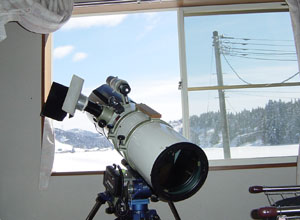
This is the first trail and is convenient when
the weather is unstable like this predawn. Off course, the search
area is restricted to about 50 degrees x 40 degrees.
Not to change the subject but snow depth reached
over three meters (ten feet) this month. You can see how it varied
by comparing two photos (below and Jan 12).

Fri Jan 28
It was one hour before the moonrise when I began
to comet hunt this evening. Thin cloud that spread just after
the beginning of this session as well as light pollution from the
ski fields reduced the contrast in the field. A 10 th magnitude galaxy
in the constellation of Pisces was bright enough to note under such
a condition.
Soon after observing the galaxy, to avoid the
cloud on the SW I trained my 18�h telescope on the NW. I could
enjoy the star ground in Cygnus at the end of January.
At the time of the moonrise I stopped comet hunting
and observed Comet Machholz near the double cluster. The iron
tail was longer than 2 degrees and the dust was some one degree
long. The two objects were seen in the same field of 50 mm finder
or 50 mm binocular. It was stunning! I remembered that I observed
this comet approach M45 on January 8 using 7x50 binocular in the gap
of the cloud.
I was surrounded by snow wall in 7 feet deep
and most cars went through did not notice me. Nevertheless, a
car slowed down to glance at me and one minute later it returned to
the observing site. A man spoke to me and asked me to show something.
I showed him Comet Machholz, the double cluster, M45, M42, Saturn
and M1.
He said it was the first time to observe using
telescope and to see so many stars. I briefed him on the outline
of each object we observed. He seemed to be impressed. He thanked
me and left. Three minutes later he came back and gave me a can
of hot chocolate.
Thu Jan 20
Incidentally, I wake up at 4:30am. Unexpectedly,
full of stars spread! It was only one hour before the beginning
of the twilight. I decided to start comet hunting in front of my
residence but could not afford to assemble 18�h telescope; it would
take some�@25 minutes. In addition to that, there is no enough space
to set it up due to piled up snow that was cleared away from the road.
I pulled 8�h reflector out and began to comet seeking.
I caught only a couple of Messier Objects, M14
and M 27. M56 and M 57 were expected to catch, however, a piece
of cloud covered them. Albireo, Beta Cyg, looked golden and emerald
green pair this time. It seemed as if they had tried to approach
each other at one moment and to go away at another moment because
of bad scintillation caused by low altitude; they were chattering.
It was only an hour searching session but I
was satisfied with it. This might be the sole comet hunting
session in this month.
Wed Jan 12
Snow depth reached 212 cm (7.1 feet) at 9am
in my workplace. This depth itself is no wonder in this city
but it is record level that the depth increased from 70 cm (2.3
feet) to 212 cm for four days. Depth of newly fallen snow during
24 hours recorded 88 cm (2.9 feet) at 9am this morning that is the
sixth highest since 1918 when my workplace began to observe.
Citizens are very busy to plow snow out.
Left: A staff of my workplace is snowplowing
nea‚’ the entrance.
Right: A man is plowing away snow on the roof.
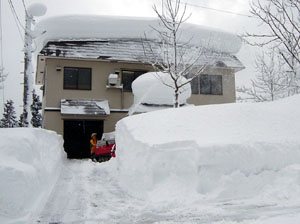
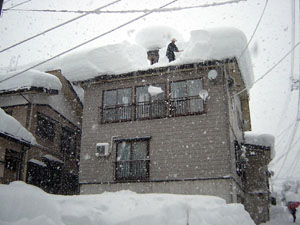
Sat Jan 8
Snow depth is over 70 cm (2.3 feet) in this
morning. Here, on Japan Sea side we have few fine days in this
month. On the contrary, astronomers can enjoy clear sky on Pacific
Sea side, where most big cities, Tokyo, Nagoya and Osaka are located
and most population in this country is concentrated.
However, there is a plus side on Japan Sea
side. Light pollution is less serious here than on Pacific
Sea side due to low population density on Japan Sea side. I think
this is attributed to the heavy snow in this region.
According to the weather forecast it snows
throughout the day today, but blue sky appeared for about
one hour (refer to the photo below) and it snowed again after
that. How beautiful the sky is! This moth I am looking forward
to scarce fine days.
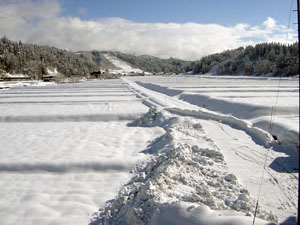
Snow covered rice farm in front of my residence.
This side of the road is snowplowed and here is the end of
the snowplow. I sometimes comet hunt here. The center of the
picture is the east –southeast.
Top of this
page




 �gHunter of the starry heavens�h by Tsutomu Seki
�gHunter of the starry heavens�h by Tsutomu Seki

 Click the photo to enlarge!
Click the photo to enlarge!

